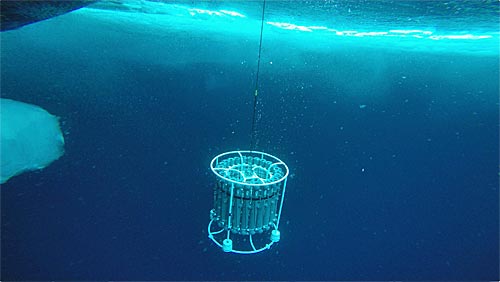
TODAY’S JOURNAL:
One of the major aspects of the 2015 US Arctic GEOTRACES Expedition was to obtain water samples for various trace element and nutrient testing. The most significant tool that oceanographers use for collecting water samples from different depths is a CTDA research tool that is submerged in the water to measure conductivity (salinity), temperature, and depth. sampling rosette. Several of my journals touched upon this process, including entries from 11 August and 12 August.
In the first video, I wore a GoPro on my hard hat to show the process of getting the GEOTRACES rosette ready for a cast. The crew works to clear an open pool behind the Healy using propeller wash and ice poles. We begin by uncovering and untying the rosette frame (it is kept covered both to keep it clean and to keep it warm via electric heaters.) Then the trace-metal clean GoFlow bottles are brought out from the GEOTRACES van and mounted on the rosette. Each bottle is connected to the trigger carousel at the top of the frame so they can be remotely triggered. After pulling off the shower caps (yeah, that’s what they are!), the device is ready to be lowered into the ocean via the aft A-frame crane. Finally, the whole shebang is reversed after the rosette is recovered. Then the team inside the GEOTRACES van can commence dividing up the water samples from each bottle (a process called sub-sampling) for various scientists to use in their studies.
Here’s another video of the GEOTRACES rosette in operation, this time from the perspective of a seal in the icy arctic ocean. I also shot this with a GoPro, this time mounting it on one of the long aluminum poles used to fend off ice.
We had another CTDA research tool that is submerged in the water to measure conductivity (salinity), temperature, and depth. sampling rosette operating from the starboard side on our expedition- it was run by the ODF (Oceanographic Data Facility) team. This sampling rosette wasn’t trace-metal clean, and was used for sampling operations that aren’t as prone to contamination. They had the advantage of staging and sampling in the starboard staging bay, which is out of the weather and has a heater! Here’s a time-lapse showing the rosette deployment, recovery, and sampling operations as seen from above in the starboard staging bay:
We didn’t only sample water using the rosettes- there were a few different pumping operations as well, in addition to using the ship-board flow-through surface water sampling system which ran 24/7. Here’s video showing the process of Beryllium-7 sampling at one of the ice stations, which involves pumping hundreds of liters of water per sampling depth up through special filters that chemically trap the Beryllium-7. My 20 August journal explains the process in more detail.
That's all for now. Best- Bill


Comments